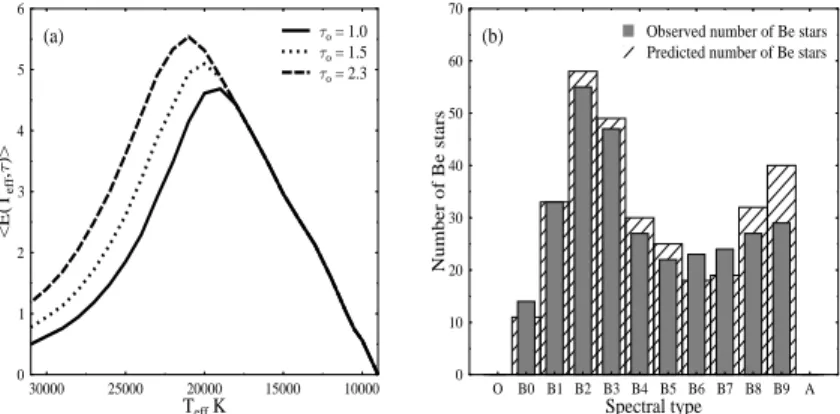HAL Id: hal-00008526
https://hal.archives-ouvertes.fr/hal-00008526
Submitted on 7 Sep 2005
HAL is a multi-disciplinary open access
archive for the deposit and dissemination of
sci-entific research documents, whether they are
pub-lished or not. The documents may come from
teaching and research institutions in France or
abroad, or from public or private research centers.
L’archive ouverte pluridisciplinaire HAL, est
destinée au dépôt et à la diffusion de documents
scientifiques de niveau recherche, publiés ou non,
émanant des établissements d’enseignement et de
recherche français ou étrangers, des laboratoires
publics ou privés.
ON THE FREQUENCY OF FIELD GALACTIC Be
STARS
Juan Zorec, Yves Fremat
To cite this version:
Juan Zorec, Yves Fremat. ON THE FREQUENCY OF FIELD GALACTIC Be STARS. Societe
Francaise d’Astronomie et d’Astrophysique, 2005, France. �hal-00008526�
ccsd-00008526, version 1 - 7 Sep 2005
SF2A 2005
F. Casoli, T. Contini, J.M. Hameury, and L. Pagani (eds)
ON THE FREQUENCY OF FIELD GALACTIC BE STARS
Zorec, J.
1and Fr´emat, Y.
2Abstract. Since Be stars belong to the high velocity tail of a single B star velocity distribution, the appearance of the Be phenomenon must be independent of the stellar mass. In the present paper we show that the shape of the distribution of the number fraction N(Be)/N(Be+B) against the spectral type can be explained in terms of the Balmer line emission efficiency as a function of the effective temperature.
1 Introduction
Field Be stars near the Sun represent a sample of objects in different stages of the main sequence evolutionary phase (MS). Several hypothesis have been put forward to explain the distribution of the frequency of Be stars against the spectral type. As Be stars belong to the high velocity tail of a single B star velocity distribution (Zorec et al. 2005, Martayan et. al. 2005), there is no physical reason that the fraction of Be stars be mass-dependent as apparently it comes up from statistics.
2 Method
In this contribution we show that the observed distribution of the frequency of Be stars is determined by the Balmer line emission efficiency as a function of the effective temperature. The probability of detecting a Be star can be written as:
dN (Be, i) ∝ PBeEHα(Teff, τ, i)φ(τ )N (Teff) sin idτ di (2.1)
where PBe is the probability that a B star becomes Be; EHα is the average
in-tensity of the Hα emission produced by a circumstellar disc of opacity τ in the center of the Hα line seen under an aspect angle i; φ(τ ) is the probability the disc
had an opacity τ ; N (Teff)is the total number of stars having effective temperature
Teff; sin i is the probability of seeing the disc at an inclination i. The emission
intensity factor is EHα(Teff, τ, i) = SHα∆(i)(1 − e−
τ
cosi), where SHα(T
eff) is the
1
Institut d’Astrophysique de Paris, UMR7095 CNRS, Universit´e Pierre & Marie Curie 2
Royal Observatory of Belgium
c
2 SF2A 2005
photoionization-, thus, Teff-dominated Hα line source function; ∆(i) contains
ge-ometrical parameters of the disc, which we assume be the same for all stars. The
expected number of Be N (Be) is then given by N (Be) = βF (Teff, τo)N (B + Be),
where N (B + Be) is the number of all stars in the studied mass or Teff interval.
Since we assume PBe(M ) = constant, it comes up that β = constant which implies
the number of expected Be stars in a given mass range is not mass-dependent.
3 Results and Conclusions
Figure 1a shows E(Teff, τ) against Teff and τo. To represent N (M ) we used the
total counts of B and Be stars per mass interval in the V = 7 magnitude limited volume around the Sun, so as to reflect closely the local IMF. Figure 1b shows the histogram of the observed fractions of Be stars and the histogram predicted
by (2.1) with τo= 1. Distributions resemble each other closely and maxima at B2
and from B7/8 are well accounted for. The maximum at B2 is due to the high Hα emission, while that at B7/8 is due to the increase of the IMF function. The slight excess of predicted Be stars in the cool extreme of the distribution can be due to stars that have not yet developed the Be phenomenon and to actual Be stars with too tiny or cool discs whose emission has remained unseen. There is enough fast rotating B stars, called Bn stars, which can fit the excess predicted in the low temperature side (Zorec 2004).
30000 25000 20000 15000 10000 TeffK 0 1 2 3 4 5 6 <E(T ef f , )> o= 2.3 o= 1.5 o= 1.0 (a) O B0 B1 B2 B3 B4 B5 B6 B7 B8 B9 A Spectral type 0 10 20 30 40 50 60 70 Number of Be stars
Predicted number of Be stars Observed number of Be stars
(b)
Fig. 1.(a): Emission intensity function in the Hα line as a function of Teff and τo. (b)
Observed and predicted number of Be stars
References
Martayan, C., Zorec, J., Fr´emat, Y. et al. 2005, SF2A/2005, this issue
Zorec J., Martayan, C., Fr´emat, Y. et al. 2005, in: Active OB-Stars: Laboratories for Stellar and Circumstellar Physics, Workshop
